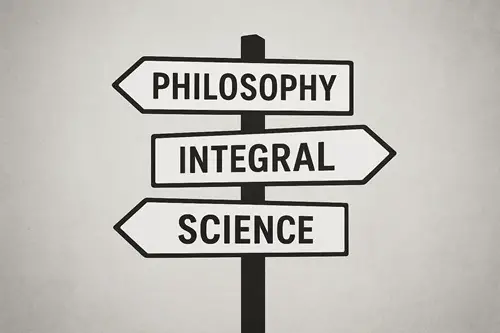|
TRANSLATE THIS ARTICLE
Integral World: Exploring Theories of Everything
An independent forum for a critical discussion of the integral philosophy of Ken Wilber
Check out my other conversations with ChatGPT
WHEN CHATBOTS START DEBATING INTEGRAL
Visser1 | Rost1 | Visser2 | Rost2 Visser3 | Rost3 | Visser4 | Rost4 Visser5 | Visser6 - Conclusion Beyond Scientific DogmaIntegral as a Universal MethodMark Rost / Gemini
 The rejoinder, “Why Integral Still Lacks a Science Department,” powerfully argues that Integral Theory engages in a methodological bait-and-switch: it borrows the authority of science but evades its discipline. The critique is trenchant, but it operates from a premise that Integral Theory itself calls into question: the idea that the scientific method is the ultimate arbiter of all truth claims. By viewing this debate through a wider lens, specifically that of Billy Koen's “universal method,” we can see that Integral is not evading discipline but proposing a more comprehensive one. Its methodology is not unscientific; it is trans-scientific. 1. Science as a Subset of a Universal MethodThe critic insists that “once science is invoked… the rules of science apply.” But which rules? Philosopher of engineering Billy Koen, in his work Discussion of the Method, argues that the celebrated "scientific method" is not a singular, monolithic procedure but a collection of context-dependent heuristics (rules of thumb). He proposes that science, engineering, and even everyday problem-solving are all subsets of a single, universal method: “Do the best you can with what you have to get what you want.” In this light, the scientific method is simply the specific set of heuristics that has proven most effective for what science wants: predicting and controlling the objective, exterior world (the Right-Hand quadrants). Its tools—falsifiability, empirical measurement, peer review—are exquisitely adapted for that purpose. Integral Theory, however, wants something different. It seeks to create the most comprehensive and coherent map of reality possible, one that includes not only the objective world but also subjective experience (consciousness) and intersubjective reality (culture). Therefore, it must employ a different, broader set of heuristics. 2. The Integral Method: A Four-Quadrant HeuristicThe Integral method is not an abandonment of discipline; it is an expansion of it. While the scientific method primarily operates in two quadrants (the Upper-Right of individual objects/organisms and the Lower-Right of systems), the Integral method is a heuristic for integrating all four:
The discipline of the Integral method lies in its commitment to finding a coherent pattern that connects the valid truth claims from all these domains. Accountability is not thrown out; it is squared. A claim is judged not only on its empirical falsifiability but on its phenomenological veracity, its cultural coherence, and its systemic fit. 3. Eros: A Postulate for the Left-Hand QuadrantsThe critique that Eros is either a “redundant metaphor or a pseudoscientific hypothesis” stems from trying to force a Left-Hand concept into a Right-Hand box. From the perspective of the Integral method, Eros is neither. It is a Left-Hand postulate—a hypothesis about the interior quality or drive that corresponds to the exterior phenomena of self-organization and complexification that science observes. Science can and should describe the external mechanisms (natural selection, thermodynamics), but it is methodologically prevented from investigating the interior drive. Is there a "pull" toward greater consciousness? Science cannot answer that, any more than it can measure "love" with a voltmeter. Integral Theory posits that this interior dimension is real and essential for a complete explanation. This isn't a competition with natural selection; it's the proposal of its interior correlate. 4. Accountability Beyond FlatlandThe charge that calling critiques "flatland" is a way to immunize Integral Theory from falsification is a serious one. But the term is not meant to dismiss empirical accountability; it is meant to identify a category error in the accountability itself. To demand that the entirety of the Integral map be subject to the rules of one of its territories (empirical science) is the definition of reductionism. It is like demanding that a literary critic's interpretation of Hamlet be falsifiable in a laboratory. The interpretation must be accountable, yes—but to the text, to historical context, to hermeneutic principles—not to the scientific method. Similarly, Wilber's evolutionary claims should be consistent with the findings of biology—and where they are not, critiques like Frank Visser's are essential correctives. But the overarching philosophical framework itself—the one that correlates biology with psychology and spirituality—must be judged by a broader, more inclusive set of criteria: its coherence, its comprehensiveness, and its capacity to make sense of the whole. Conclusion: Cartography, Not ColonizationIntegral Theory is not clothing a grandiose ideology in scientific language; it is practicing a form of comprehensive cartography. It is drawing a map that shows how the territory of science relates to the territories of art, ethics, and spirit. A true “science department” within Integral would not be a place to replicate biology labs. It would be a department of methodology—one that respects the power of the scientific method within its domain while engaging it in a deeper dialogue with the methods of the humanities and the contemplative traditions. It would not risk falsification on science's terms alone, but on the integrated terms of all four quadrants. This is not a retreat from discipline but an advance toward a more profound and holistic intellectual rigor. It is not a map without a territory, but a map capacious enough to hold all the territories we inhabit.
Comment Form is loading comments...
|